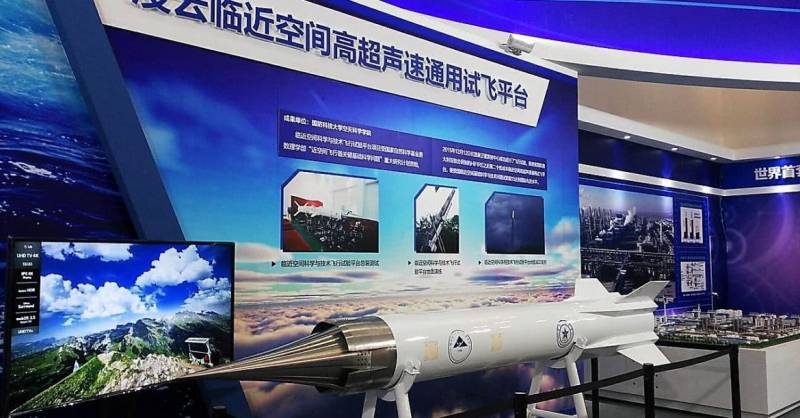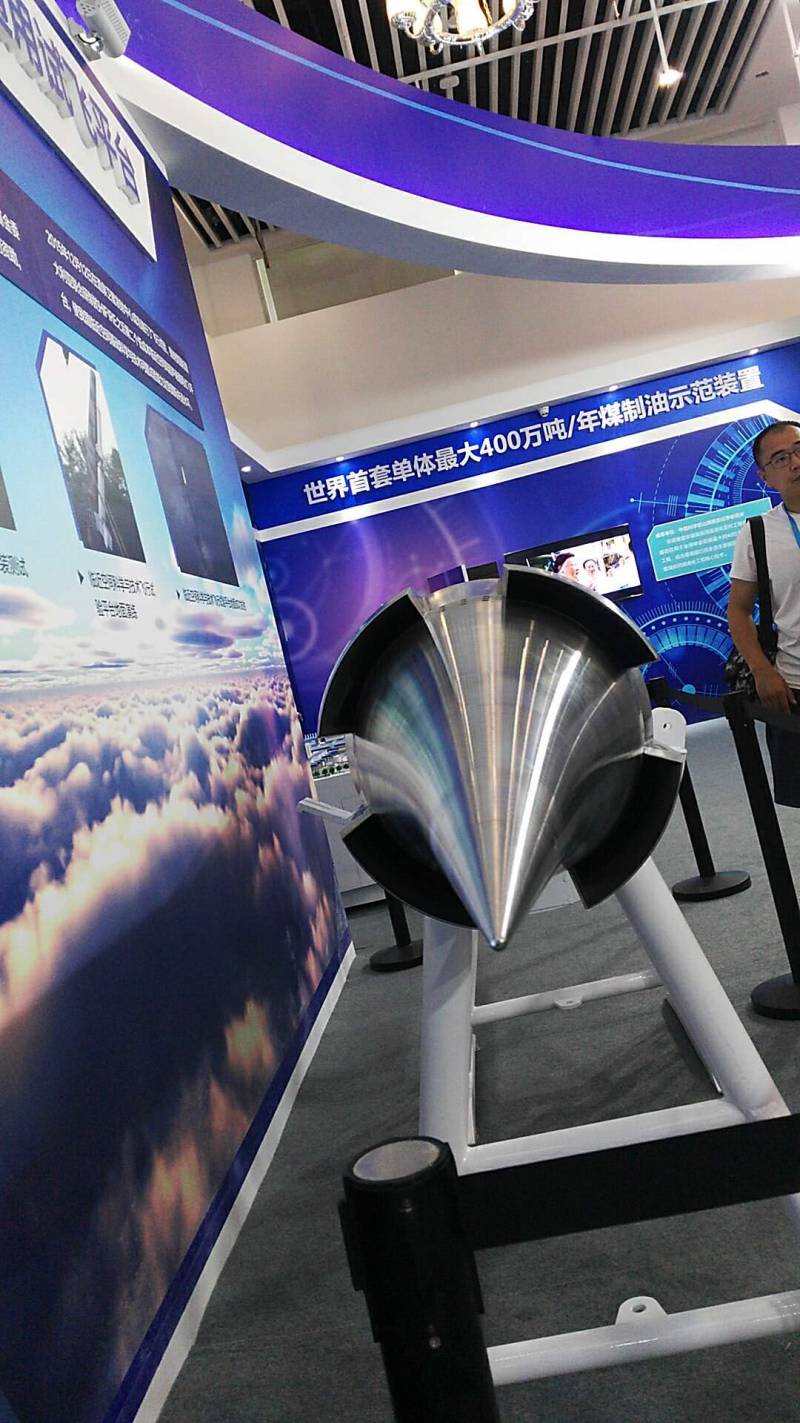The project "Lin Yun-1". New technologies for Chinese hypersound
Rocket premiere
In May 2018, the next Science and Technology Week was held in Beijing. This event has already become a familiar platform for demonstrating new developments in Chinese industry, including in the most advanced areas. Last year, the most interesting exhibits related to rocket technology.
At one of the exhibition stands was a mockup of a previously unknown rocket, designated as “Lin Yun-1”. A booth with several photographs and basic information about the project was demonstrated along with it. It is curious that before the 2018 Week of Science and Technology, only the project participants knew about the existence of this hypersonic missile. However, reports on the development of technologies used in the Lin Yun-1 project have repeatedly appeared in the past.
The development of a new product was carried out by the College of Aerospace Science and Technology at the Defense Scientific and Technical University of the PLA. A number of other scientific and design organizations participated in creating the necessary technologies. During the exhibition, some technical details of the project and the main characteristics of the finished rocket were revealed.
Technical appearance
"Lin Yun-1" is an experimental rocket, built on the basis of a hypersonic ramjet engine of its own Chinese design. The use of such a propulsion system determined the main features of the appearance of the rocket and provided the required characteristics.
The missile has an elongated cylindrical body with a pointed head fairing. At the rear of the fairing are four air intakes protruding into the stream. In the rear of the hull thickenings are provided on which trapezoidal stabilizers are installed. The layout of the rocket should be simple. Apparently, the main volume of the hull is occupied by the marching scramjet, and the other compartments are given for control equipment and fuel.
In addition to the march scramjet, the rocket propulsion system includes a launch accelerator. With it, the rocket accelerates to the operating speeds of the main engine. At the exhibition, Lin Yun-1 was shown without this unit, in flight configuration.
Of all the technical characteristics of the rocket, only speed was announced. Thanks to the scramjet engine, this parameter reaches 6100 km / h - five times the speed of sound.
In December 2015, the Lin Yun-1 rocket completed its first test flight. Its results are not specified. Further events around this product are also unknown. Perhaps, from the end of the 2015 to May 2018, the experimental rockets made several more flights. Information on this subject has not yet appeared.
Technological foundation
According to official data, the Lin Yun-1 rocket was developed as a flying laboratory to test new solutions and technologies that could find application in future projects. The developers have successfully solved a number of critical technical problems and laid the technological foundation for new developments in the hypersonic field.
“Lin Yun-1” is a multi-purpose hypersonic missile with a simplified design and, as a consequence, reduced cost. It was also indicated that in terms of basic technology and mission, the Chinese missile is similar to the HIFiRE product of a joint US-Australian development. It is expected that the developments on such a product will be useful in various fields.
Material science issues in the context of a pilot project remain unsolved. Apparently, Lin Yun-1 is built from heat-resistant alloys that can cope with the thermal and mechanical stresses of hypersonic flight. However, the exact materials are unknown.
The problem of thermal loads found an interesting solution that is directly related to the design of the propulsion system. The design of the rocket and engine is cooled by fuel, which is used as aviation kerosene. Tanks and fuel lines are constructed in such a way that the circulating fuel takes away excess heat from metal units.
Through the use of kerosene, it is planned to solve another important issue relating to the further development of hypersonic technology. In terms of energy or design cooling efficiency, kerosene is inferior to some promising fuels, but still has the advantage of high availability. Such fuel is available at any airport in China, and in the future it will greatly simplify the operation of new missiles or other equipment.
In this regard, the development of scramjet engine on kerosene has a high priority, and it was such a unit that was created for the Lin Yun-1 flying laboratory. Moreover, he had already passed some tests and, probably, showed himself well.
Applications
The Lin Yun-1 rocket is positioned solely as a flying laboratory and technology demonstrator. The implementation of new technical solutions in the practical field will be carried out with the help of other projects. Last year, Chinese experts uncovered possible areas of application of new technologies.
The scramjet will be useful in the military sphere. With its help, it is possible to create promising missile weapons with the highest flight speed, capable of overcoming the existing air defense. It should be noted that in foreign publications following the first show of “Lin Yun-1”, it was precisely this application of new hypersonic technologies that was most actively discussed.
The new propulsion system may find application in civil aviation. In the future, it is possible to return to the concept of a high-speed passenger aircraft equipped with a scramjet or other installation with similar capabilities. In China, possible options for the appearance of a passenger plane with a speed of more than 8400 km / h are already being explored. Such a machine will be able to cover the distance from Beijing to New York in about two hours. The Lin Yun-1 laboratory can also contribute to such a project.
New higher-performance scramjet engines can also be useful for the development of space rocket technology. A reusable spaceship with such engines is not easy to develop, but promises certain advantages. Techniques of this kind can spur the development of science and space tourism.
From experiment to weapons
Most of the ways to apply the technologies of the Lin Yun-1 project so far relate to the distant future. Of course, if it comes to the real development of a reusable space system or passenger aircraft with a scramjet. Much more realistic and useful from the point of view of practice is the creation of new missile weapons.
In the short term, Lin Yun-1 may become the basis for several types of missiles and various purposes. The most effective samples can be air-to-surface and surface-to-surface guided hypersonic missiles. Such weapon will find application in tactical aviation, in the naval forces and coastal forces.
In the Lin Yun-1 form factor, you can create an aircraft missile to destroy ground or surface targets. A hypersonic anti-ship missile of this kind can enter the ammunition load of surface ships, submarines or coastal complexes. In all cases, the new weapon will have high combat potential associated with hypersonic speed and kinetic energy. In the current conditions, such weapons are of great interest to any army, and the PLA is no exception.
It is obvious that the technologies developed with the help of the Lin Yun-1 demonstrator will first of all find application in the military sphere, and in the foreseeable future the Chinese army will receive a fundamentally new weapon. The use of hypersonic technologies in other areas is also possible, but such projects will not receive the same priority. In this regard, China will repeat the approaches of other countries, and will take all measures to obtain promising weapons as soon as possible.


Information